- Getting around Lijiang. Dont stay in the Old Towns more than 2 days, there is nothing to do. KRISS Oct 9, 2013 05:46
- 2013 Beijing Temple Fair BENNYLAU Feb 26, 2013 03:29
- Malaysian traveling from KUL - LAX vis Shanghai PVG ZATI_DY Jan 3, 2013 20:15
Luzhou Laojiao 1573
- Views: 13744
- |Vote: 0 0
- |Add to Favorites
- |Recommend to Friends
The drink
It seems every city in China is famous for something whether it be people, places or produce. Luzhou is no exception, being quite famous throughout China for its unique laojiao bai jiu or ‘white wine’ liquor. Laojiao, meaning ‘old cellar’, refers to the old clay cellars that are still used today in the fermentation of the daqu ‘grain mash’ and greatly influences the final taste of the wine. Luzhou’s ‘laojiao daqu’ is considered one of the finest in all of China. According to Chinese connoisseurs, the most unique characteristic, other than the robust bouquet, is the extremely long aftertaste that is reminiscent of a fresh apple.
Luzhou daqu uses a mixed distillation technique with uninterrupted fermentation where fresh flour is mixed with the fermented grain before distillation. Special yellow clay found a short distance from Luzhou is used for the cellar's walls. It is mixed with the yellow floor water from an old cellar, and then compacted and applied to the walls. The yellow clay on the walls is then allowed to dry during which time it changes colour first to black and then white when it finally becomes hard and brittle. After 20 years or so, the grayish-white cellar walls turn grayish-black with red and green spots. At this point, it may be considered old, and the quality of the liquor improves with the age of the cellar. It is said that the invisible microbes in the clay contribute to the unique flavour of each laojiao daqu.
The smell
A bit of a misnomer outside China, this potent white spirit 白酒 bai jiu, translated ‘white wine’ is generously imbibed in tiny porcelain shot glasses. A meal is rarely complete without the profuse toasting between mouthfuls to good health, good company and success by businessmen and women or friends and colleagues at social gatherings both day and night. This clear liquor usually distilled from grains like rice and wheat, with an alcohol content of more than fifty percent, and often considered by others to be little more than paint stripper, is guaranteed to warm you from the inside out on a cold night but will leave you momentarily gasping for air.
One of the first things a visitor to Luzhou will notice is the strong, pungent odor of fermenting grains and yeast that hangs over the city on still days or wafts on the breeze. Production of this popular liquor was thought to have started only during the Song Dynasty (960-1279) but an ancient porcelain kiln was unearthed recently in Yinggoutou at the foot of Fenghuang Shan, another source of suitable clay and the site of many original clay cellars. Really just a small hill, it is still the site of a distillery - that of today’s 1573 brand of bai jiu. Some of the exquisite ‘wine’ vessels found at the site date back as far as the late Tang Dynasty (618-907) and are displayed on the third floor of the Luzhou Museum.
The connection
I had traveled through Luzhou once before seeing little more than two of its many bus stations. But this time I returned with two friends to visit another friend now working at the No. 2 Middle School in Luzhou, which ironically is situated on the crest of Fenghuang Shan (Pheonix Mountain), overlooking the 1573 distillery. Our hotel was on the street opposite the distillery so we quickly grew accustomed to the smell as most of the locals do. The school campus, which is bathed in the pungent smell most of the time, is compact with tall shady trees and small gardens throughout. Most buildings are new or recently renovated and the foreign teachers accommodation while deceptively old from its outside appearance is modern, comfortable and well equipped. In close proximity to the campus is everything students and staff could wish for and it is just a short walk to the cosmopolitan ‘walking street’, the downtown and the beautiful tree lined Nanbin Lu, a shady esplanade of outdoor teahouses which stretches for kilometers along the low banks of the Yangtze.
The fruit
Luzhou, like many of China’s river cities is located on the junction of two rivers, the Chang Jiang and the Tuo Jiang in the rich agricultural area of southeast Sichuan. At one time a bustling port and commercial center between Yibin and Chongqing trading in salt, tea and grain it lost prominence when the rail line bypassed the city taking much of its freight and trade with it.
The father of one of my Chongqing friends has for many years skippered a light freighter on the Yangtze River. When she was young, he would often take her with him upstream on these trips, returning from Luzhou to Chongqing with a cargo of fresh fruit and vegetables and a surprise gift for her mother – bunches of local longan fruit.
Known in China as the Dragon Eye fruit, it came originally from India, Burma and Ceylon, and is now grown extensively in southern China. The longan tree (Euphoria longana) is a member of the unusual and diverse Soapberry Family. Another of Luzhou’s famous products the longan is a delicious fruit which is high in iron content - much more than grapes or spinach and used by the Chinese as a blood tonic, to nurture the heart, and to add luster and beauty to the skin. It is believed among the Chinese people that longan is not only a great tonic for the skin, but also a great sex tonic.
The history
The dominating attractions of the city are it’s two towers, one the ancient and beautiful, seven story, white Bao’en Pagoda and the other the pretty blue gray Clock Tower. The later is said to have been built by the British around the turn of the last century and to have taken a direct hit during a fierce bout of fighting between the Communist and Nationalist armies. Fortunately only the top was damaged and it was finally restored in the 1970’s and now looks majestically over the modern, noisy, tree lined streets down to the river.
Luzhou was opened as a foreign treaty port in the early 1900’s and the Canadian Methodist Mission built a hospital here in 1913. Two of the original churches built by the early missionaries to the region are still used today. One is the Catholic Church and the other is the one built by the Canadian Methodist Mission more than one hundred years ago. Today it has a new blue tiled façade, operates a small medical clinic and a kindergarten teaching English
The attractions
Zhongshan Park in the center of the peninsular is a popular amusement center for both young and old. It offers a variety of activities and rides including dodgem cars and a roller coaster that is not likely to trill anyone over the age of five. Flanked by nurseries lining the road at the back of the park it is also home to an aviary with the surprising residents – some emus and black swans. We amused ourselves on the ‘spaceship’ ride and then watched as the people of Luzhou politely watched us. The people of Luzhou are friendly and this was one of few places where I have not heard ‘waiguoren’ and giggles follow us almost everywhere we went. Young and old are curious and often said hello as we approached them, many more were happy to be photographed and wanted to know if we were all from the same country. In fact we were from four different countries and from the four corners of the globe.
Luzhou lacks little and we were impressed with the fact that it also boasted a ‘revolving’ restaurant on the top floor of the Lao Jiao Hotel which sits close to the tip of the peninsular and affords excellent views of the rivers and the city as you slowly revolve above them. During the day we had noticed that the restaurant appeared not to be revolving but we went anyway, knowing that the view and the food would be worth it. Apparently the motor that turns the dining platform was out of order so we had to walk around to appreciate the 360° view. Other curious but friendly guests welcomed us heartily, many empty bottles of the deadly laojiao baijiu evidence that they had been partying long and hard. We then sat down to a truly international dinner. We were seven different nationalities. We had come to visit one friend and made a few new ones as we dined in Luzhou’s non-revolving restaurant.
The locals
While the main streets of Luzhou are lined with trees and modern glass fronted shops and department stores selling everything from underwear to computers, the back streets reveal a different story. They offer everything from live fish in tanks, freshwater crayfish, crabs, chickens and ducks, live, raw or roasted. Grains and pulses, garlic and chilies, bamboo shoots, lungs and livers. Woks and pans, broom and mops, tobacco, cigarettes, drinks and snacks.
A few beggars with gross deformities braved the cold, obstructing the pavement in the hope of attracting a few ‘fen’ from passing shoppers. Across the Tuo River are the markets and warehouses, an area bursting with cheap and colourful wholesale merchandise from blankets to winter weight sleeve protectors and jackets. No matter where we walked, farmers roamed the streets selling their produce - chickens, eggs or fresh fruit and vegetables from a pair of well-balanced hand woven baskets hanging from a shoulder pole.
We took a walk up an old alley behind the markets to find a few traditional style bamboo and mud plaster houses lining the slope. Brick walls eventually gave way to older walls constructed of river rocks. An old woman of seventy-seven selling noodles passed us on the stairs with a basket on her back. The locals told us the stairway and river rock walls were over a thousand years old. A dressmaker and barber, card room and copy shop overlooked the stairs today but it was not hard to imagine a time long past. At the top of the hill we came across a street market with vegetables and other tasty snacks. One couple were deftly making waffles, the man skillfully juggling three griddles over hot coals while his wife gently rolled the soft waffle cones as they cooled and placed them in a bag ready for sale.
The End
The year is no longer 618 or 1573, but Luzhou, famous or not has more than enough to interest a visitor passing through southern Sichuan in search of something unique.



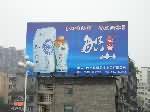
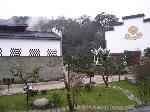

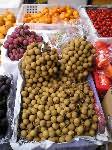
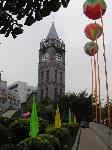
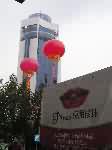
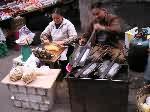
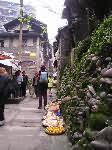
 Copyright © 1998-2025 All rights reserved.
Copyright © 1998-2025 All rights reserved.
1.
Jan 17, 2006 08:27 Reply
CARLA said:
Dear sir,do you know the famous view named "the Bamboo sea of the south of Sichuan"? it is the hometown of another famous wine named "wuliangye".